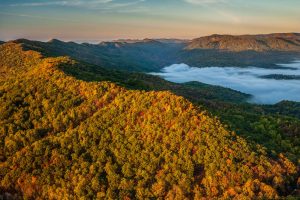The Nature Conservancy (TNC) announced it has arranged the acquisition of 100,000 acres of working forestland in the globally significant Central Appalachian Mountains of southeast Kentucky and northeast Tennessee.
The property, known as “Ataya,” represents one of the largest land conservation and ecological restoration projects TNC has targeted in the Central Appalachians. The transaction included approximately two million tons of carbon offsets eligible for the California cap-and-trade market.
TNC aims to manage the property as a working forest, using sustainable forestry practices to improve and maintain the health of the forests. The project aims to protect wildlife habitat, secure clean water for people and nature, and sequester atmospheric carbon to mitigate climate change, all while fostering important investments in local economies.

Mountain view of the Ataya tract and Cumberland Mountains from Cumberland Gap National Historic Park in Tennessee. (Photo by Byron Jorjorian)
The Central Appalachians are home to a confluence of conservation values: a globally significant biodiversity hotspot, a major North American migratory corridor, and important watersheds. The property has been identified by TNC scientists as climate-resilient and contains 200 miles of headwater streams. The property is home to more than 100 species of Greatest Conservation Need (GCN) according to state wildlife action plans, including the little brown bat, eastern meadowlark, black sandshell mussel, cerulean warbler, black mountain salamander, and many more. The property also provides crucial headwater protection for the federally endangered Kentucky arrow darter.
“One of the unique aspects of this project is that it recognizes the importance that this area provides to people and the local communities,” said Terry Cook, state director for TNC in Tennessee. “Kentucky and Tennessee forests have a tremendous economic impact, generating billions of dollars of economic activity and tens of thousands of jobs. Additionally, these lands support growing outdoor recreation opportunities. In Kentucky and Tennessee the annual economic impact of outdoor recreation exceeds $13 billion and $20 billion, respectively.”
In addition to their ecological importance, the forests and streams on the property influence water quality and public water supplies in portions of Bell, Knox and Leslie counties in Kentucky, and Claiborne and Campbell counties in Tennessee. The property provides a critical linkage between the North Cumberland Wildlife Management Area in Tennessee and the Cumberland Gap National Historic Park and Kentucky Ridge State Forest in Kentucky.
All of these areas represent core habitat along the Cumberland-Pine Mountain corridor, which is projected to be one of the most important migratory corridors in the face of a changing climate. Many people currently use and enjoy the property for hiking, hunting, and other outdoor recreation pursuits. In taking on this project, TNC is committed to connecting its conservation work to the needs and interests of local communities.
As is common in this region, ownership of the property is divided in two: a surface estate, which was acquired in this transaction, and a sub-surface mineral estate, which will continue to be owned by third parties. TNC has no control over those parties’ mining activities on the property. TNC aims to work with regulators and mining companies using a collaborative, science-based approach to advocate for best environmental practices and restoration that can minimize the impacts of mineral extraction.
As the surface owner, an affiliate of TNC expects to receive compensation for any impacts these existing mining operations have on the property’s forests and infrastructure, and can direct those funds to restoration and conservation activities on the property. In addition, the surface owner is expected to receive royalties, which the affiliate plans to contribute in their entirety to third-party community organizations to support local economic and community development efforts.
This project is being supported in part by a Program-Related Investment loan from the Doris Duke Charitable Foundation.
“We’re excited to make the largest single investment in the Foundation’s history to help protect this essential piece of the Appalachians, North America’s most critical climate migration corridor,” said Sacha Spector, program director for the environment at DDCF. “This project offers a spectacular demonstration of how land conservation and restoration at this scale can safeguard wildlife, support a community’s livelihoods, and secure the climate resilience of an entire region.”
From The Nature Conservancy






















